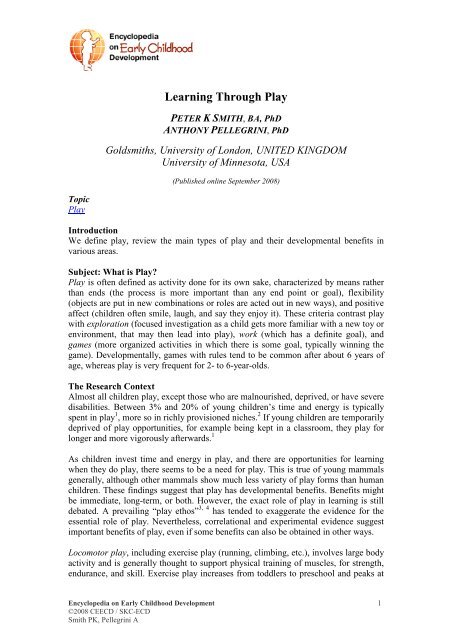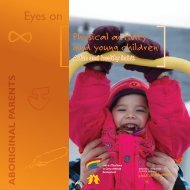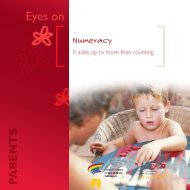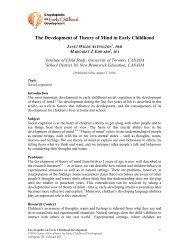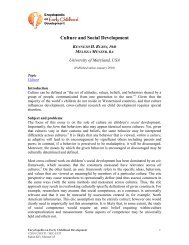Learning through play - Encyclopedia on Early Childhood ...
Learning through play - Encyclopedia on Early Childhood ...
Learning through play - Encyclopedia on Early Childhood ...
Create successful ePaper yourself
Turn your PDF publications into a flip-book with our unique Google optimized e-Paper software.
Topic<br />
Play<br />
<str<strong>on</strong>g>Learning</str<strong>on</strong>g> Through Play<br />
PETER K SMITH, BA, PhD<br />
ANTHONY PELLEGRINI, PhD<br />
Goldsmiths, University of L<strong>on</strong>d<strong>on</strong>, UNITED KINGDOM<br />
University of Minnesota, USA<br />
(Published <strong>on</strong>line September 2008)<br />
Introducti<strong>on</strong><br />
We define <str<strong>on</strong>g>play</str<strong>on</strong>g>, review the main types of <str<strong>on</strong>g>play</str<strong>on</strong>g> and their developmental benefits in<br />
various areas.<br />
Subject: What is Play?<br />
Play is often defined as activity d<strong>on</strong>e for its own sake, characterized by means rather<br />
than ends (the process is more important than any end point or goal), flexibility<br />
(objects are put in new combinati<strong>on</strong>s or roles are acted out in new ways), and positive<br />
affect (children often smile, laugh, and say they enjoy it). These criteria c<strong>on</strong>trast <str<strong>on</strong>g>play</str<strong>on</strong>g><br />
with explorati<strong>on</strong> (focused investigati<strong>on</strong> as a child gets more familiar with a new toy or<br />
envir<strong>on</strong>ment, that may then lead into <str<strong>on</strong>g>play</str<strong>on</strong>g>), work (which has a definite goal), and<br />
games (more organized activities in which there is some goal, typically winning the<br />
game). Developmentally, games with rules tend to be comm<strong>on</strong> after about 6 years of<br />
age, whereas <str<strong>on</strong>g>play</str<strong>on</strong>g> is very frequent for 2- to 6-year-olds.<br />
The Research C<strong>on</strong>text<br />
Almost all children <str<strong>on</strong>g>play</str<strong>on</strong>g>, except those who are malnourished, deprived, or have severe<br />
disabilities. Between 3% and 20% of young children’s time and energy is typically<br />
spent in <str<strong>on</strong>g>play</str<strong>on</strong>g> 1 , more so in richly provisi<strong>on</strong>ed niches. 2 If young children are temporarily<br />
deprived of <str<strong>on</strong>g>play</str<strong>on</strong>g> opportunities, for example being kept in a classroom, they <str<strong>on</strong>g>play</str<strong>on</strong>g> for<br />
l<strong>on</strong>ger and more vigorously afterwards. 1<br />
As children invest time and energy in <str<strong>on</strong>g>play</str<strong>on</strong>g>, and there are opportunities for learning<br />
when they do <str<strong>on</strong>g>play</str<strong>on</strong>g>, there seems to be a need for <str<strong>on</strong>g>play</str<strong>on</strong>g>. This is true of young mammals<br />
generally, although other mammals show much less variety of <str<strong>on</strong>g>play</str<strong>on</strong>g> forms than human<br />
children. These findings suggest that <str<strong>on</strong>g>play</str<strong>on</strong>g> has developmental benefits. Benefits might<br />
be immediate, l<strong>on</strong>g-term, or both. However, the exact role of <str<strong>on</strong>g>play</str<strong>on</strong>g> in learning is still<br />
debated. A prevailing “<str<strong>on</strong>g>play</str<strong>on</strong>g> ethos” 3, 4 has tended to exaggerate the evidence for the<br />
essential role of <str<strong>on</strong>g>play</str<strong>on</strong>g>. Nevertheless, correlati<strong>on</strong>al and experimental evidence suggest<br />
important benefits of <str<strong>on</strong>g>play</str<strong>on</strong>g>, even if some benefits can also be obtained in other ways.<br />
Locomotor <str<strong>on</strong>g>play</str<strong>on</strong>g>, including exercise <str<strong>on</strong>g>play</str<strong>on</strong>g> (running, climbing, etc.), involves large body<br />
activity and is generally thought to support physical training of muscles, for strength,<br />
endurance, and skill. Exercise <str<strong>on</strong>g>play</str<strong>on</strong>g> increases from toddlers to preschool and peaks at<br />
<str<strong>on</strong>g>Encyclopedia</str<strong>on</strong>g> <strong>on</strong> <strong>Early</strong> <strong>Childhood</strong> Development 1<br />
©2008 CEECD / SKC-ECD<br />
Smith PK, Pellegrini A
<str<strong>on</strong>g>Encyclopedia</str<strong>on</strong>g> <strong>on</strong> <strong>Early</strong> <strong>Childhood</strong> Development<br />
©2008 CEECD / SKC-ECD<br />
Smith PK, Pellegrini A<br />
PLAY<br />
early primary school ages, when the neural and muscular basis of physical<br />
coordinati<strong>on</strong> and healthy growth is important, and vigorous <str<strong>on</strong>g>play</str<strong>on</strong>g> obviously provides<br />
good opportunities for this; 5 later, it declines. There is evidence that active,<br />
<str<strong>on</strong>g>play</str<strong>on</strong>g>ground-type breaks can help young children c<strong>on</strong>centrate better at subsequent<br />
sedentary tasks, 1 c<strong>on</strong>sistent with the cognitive immaturity hypothesis that the “need to<br />
exercise helps young children to space out cognitive demands for which they have less<br />
mature capacities.” 6<br />
Social <str<strong>on</strong>g>play</str<strong>on</strong>g> refers to <str<strong>on</strong>g>play</str<strong>on</strong>g>ful interacti<strong>on</strong>s between children and parents or caregivers in<br />
children up to 2 years old, but increasingly with other children as social <str<strong>on</strong>g>play</str<strong>on</strong>g> increases<br />
dramatically from 2 to 6 years of age. At first, <str<strong>on</strong>g>play</str<strong>on</strong>g>ing with <strong>on</strong>e partner is complex<br />
enough, but by 3 or 4 years old a <str<strong>on</strong>g>play</str<strong>on</strong>g> group can c<strong>on</strong>sist of three or more participants,<br />
as children acquire social coordinati<strong>on</strong> skills and social scripts. Parallel <str<strong>on</strong>g>play</str<strong>on</strong>g>,<br />
comm<strong>on</strong> in 2- and 3-year-olds, is when children <str<strong>on</strong>g>play</str<strong>on</strong>g> next to others without much<br />
interacti<strong>on</strong>. Some <str<strong>on</strong>g>play</str<strong>on</strong>g> is solitary. 7 This type of <str<strong>on</strong>g>play</str<strong>on</strong>g> can be physical, incorporate<br />
objects or language, be pretend, or include all of these aspects. Rough-and-tumble<br />
<str<strong>on</strong>g>play</str<strong>on</strong>g>, including <str<strong>on</strong>g>play</str<strong>on</strong>g> fighting and chasing, can look like real fighting, but in <str<strong>on</strong>g>play</str<strong>on</strong>g><br />
fighting children are often laughing, kicks and blows are not hard or do not make<br />
c<strong>on</strong>tact, and it is usually d<strong>on</strong>e with friends.<br />
Object <str<strong>on</strong>g>play</str<strong>on</strong>g> refers to <str<strong>on</strong>g>play</str<strong>on</strong>g>ful use of objects such as building blocks, jigsaw puzzles,<br />
cars, dolls, etc. With babies, this <str<strong>on</strong>g>play</str<strong>on</strong>g> is mouthing objects and dropping them. With<br />
toddlers, this is sometimes just manipulating the objects (e.g., assembling blocks), but<br />
sometimes involves pretend <str<strong>on</strong>g>play</str<strong>on</strong>g> (e.g., building a house, feeding a doll). Play with<br />
objects allows children to try out new combinati<strong>on</strong>s of acti<strong>on</strong>s, free of external<br />
c<strong>on</strong>straint, and may help develop problem solving skills. Any benefits of object <str<strong>on</strong>g>play</str<strong>on</strong>g><br />
need to be balanced against those of instructi<strong>on</strong>, bearing in mind the ages of the<br />
children, the nature of the task, and whether learning is for specific skills, or a more<br />
general inquisitive and creative attitude. The more marked benefits may be for<br />
independent and creative thought, 8 though the evidence is equivocal. 9<br />
Language <str<strong>on</strong>g>play</str<strong>on</strong>g> At around 2 years old, toddlers often talk to themselves before going<br />
to sleep or up<strong>on</strong> waking up. This is <str<strong>on</strong>g>play</str<strong>on</strong>g>ful, with repetiti<strong>on</strong> and sometimes laughter.<br />
Children use language humorously at 3 and 4 years old. (“I’m a whale. This is my<br />
tail.” “I’m a flamingo. Look at my wingo.”) Language skills--ph<strong>on</strong>ology (speech<br />
sounds), vocabulary and meaning (semantics), grammar (syntax), and pragmatics<br />
(using language appropriately in social situati<strong>on</strong>s)--are rapidly developing in the<br />
preschool years. Some ph<strong>on</strong>ological skills can be developed in the solitary<br />
m<strong>on</strong>ologues when children babble to themselves in their cot, but most benefits of<br />
language learning probably come in sociodramatic <str<strong>on</strong>g>play</str<strong>on</strong>g>.<br />
Pretend <str<strong>on</strong>g>play</str<strong>on</strong>g> involves pretending an object or an acti<strong>on</strong> is something else than it really<br />
is. A banana is a teleph<strong>on</strong>e, for example. This <str<strong>on</strong>g>play</str<strong>on</strong>g> develops from 15 m<strong>on</strong>ths of age<br />
with simple acti<strong>on</strong>s, such as pretending to sleep or putting dolly to bed, developing<br />
into l<strong>on</strong>ger story sequences and role <str<strong>on</strong>g>play</str<strong>on</strong>g>. Sociodramatic <str<strong>on</strong>g>play</str<strong>on</strong>g>, comm<strong>on</strong> from around 3<br />
years of age, is pretend <str<strong>on</strong>g>play</str<strong>on</strong>g> with others, sustained role taking, and a narrative line. It<br />
can involve understanding others’ intent, sophisticated language c<strong>on</strong>structi<strong>on</strong>s, and<br />
development of (sometimes) novel and intricate story lines. Children negotiate<br />
meanings and roles (“You be daddy, right?”) and argue about appropriate behavior<br />
(“No, you d<strong>on</strong>’t feed the baby like that!”).<br />
2
<str<strong>on</strong>g>Encyclopedia</str<strong>on</strong>g> <strong>on</strong> <strong>Early</strong> <strong>Childhood</strong> Development<br />
©2008 CEECD / SKC-ECD<br />
Smith PK, Pellegrini A<br />
PLAY<br />
Many learning functi<strong>on</strong>s have been advanced for pretend and especially sociodramatic<br />
<str<strong>on</strong>g>play</str<strong>on</strong>g>. 10 One hypothesis is that it is useful for developing preliteracy skills, such as<br />
awareness of letters and print, and the purpose of books. 11, 12, 13 The narrative structure<br />
of sociodramatic <str<strong>on</strong>g>play</str<strong>on</strong>g> sequences mirrors the narratives of story books. For these<br />
benefits, some structuring by adults is helpful (in maintaining a story line, having<br />
suitable materials including plastic letters, books, etc.).<br />
Another hypothesis is that pretend <str<strong>on</strong>g>play</str<strong>on</strong>g> enhances emoti<strong>on</strong>al security. A child who is<br />
emoti<strong>on</strong>ally upset, for example, by parents arguing or the illness or death of some<strong>on</strong>e<br />
in the family, can work <str<strong>on</strong>g>through</str<strong>on</strong>g> the anxieties by acting out such themes in pretend<br />
<str<strong>on</strong>g>play</str<strong>on</strong>g>, with dolls for example. Play therapists use such techniques to help understand<br />
children’s anxieties; and most therapists believe that it helps the child work towards a<br />
resoluti<strong>on</strong> of them. 14<br />
A relatively recent hypothesis is that pretend <str<strong>on</strong>g>play</str<strong>on</strong>g> enhances theory of mind<br />
development. Theory of mind ability means being able to understand (represent) the<br />
knowledge and beliefs of others; that is, that some<strong>on</strong>e else can have a different belief<br />
or state of knowledge from yourself. This does not happen until the age of late 3 or 4<br />
years old. Social interacti<strong>on</strong> with age-mates seems to be important for this, and social<br />
pretend <str<strong>on</strong>g>play</str<strong>on</strong>g> (with siblings or with other age-mates) may be especially helpful, as<br />
children negotiate different roles and realize that different roles entail different<br />
behaviors. 15 While these benefits are plausible, there is little experimental evidence;<br />
the correlati<strong>on</strong>al evidence suggests that social pretend <str<strong>on</strong>g>play</str<strong>on</strong>g> is helpful but is <strong>on</strong>ly <strong>on</strong>e<br />
route to acquiring theory of mind. 16<br />
Key Research Questi<strong>on</strong>s and Gaps<br />
We lack descriptive informati<strong>on</strong> <strong>on</strong> the time and energy spent in various forms of<br />
<str<strong>on</strong>g>play</str<strong>on</strong>g>. Without this we cannot understand the putative benefits of <str<strong>on</strong>g>play</str<strong>on</strong>g>. Further, while<br />
<str<strong>on</strong>g>play</str<strong>on</strong>g> may have many positive benefits, this is not always so. Play fighting is viewed<br />
ambivalently by nursery staff as many staff find it noisy and disruptive, and believe it<br />
often leads to real fights. In fact, research suggests that during the primary school<br />
years, <strong>on</strong>ly about 1% of rough-and-tumble <str<strong>on</strong>g>play</str<strong>on</strong>g> bouts turn into real fighting. However,<br />
this is more frequent for some children who lack social skills and are rejected by<br />
<str<strong>on</strong>g>play</str<strong>on</strong>g>mates. These children often resp<strong>on</strong>d to rough-and-tumble <str<strong>on</strong>g>play</str<strong>on</strong>g> aggressively. 17<br />
A related area of c<strong>on</strong>cern has been war <str<strong>on</strong>g>play</str<strong>on</strong>g> (<str<strong>on</strong>g>play</str<strong>on</strong>g> with toy guns, weap<strong>on</strong>s, or combat<br />
superhero figures). 18 Carlss<strong>on</strong>-Paige and Levin 19 c<strong>on</strong>trasted a developmental view that<br />
<str<strong>on</strong>g>play</str<strong>on</strong>g> including war <str<strong>on</strong>g>play</str<strong>on</strong>g> is a primary vehicle for children to express themselves, with a<br />
sociopolitical view that children learn militaristic political c<strong>on</strong>cepts and values<br />
<str<strong>on</strong>g>through</str<strong>on</strong>g> war <str<strong>on</strong>g>play</str<strong>on</strong>g>. There is not a large research base <strong>on</strong> which to make informed<br />
judgments about whether the c<strong>on</strong>cerns are justified. Dunn and Hughes 20 found that 4year-old,<br />
hard-to-manage children showed frequent violent fantasy and the extent of<br />
this was related to poorer language and <str<strong>on</strong>g>play</str<strong>on</strong>g> skills, more antisocial behaviour, and less<br />
empathic understanding at the age of 6 years. This does suggest c<strong>on</strong>cerns for the<br />
effects of such <str<strong>on</strong>g>play</str<strong>on</strong>g> <strong>on</strong> disturbed children.<br />
Implicati<strong>on</strong>s<br />
In c<strong>on</strong>temporary societies, adults are usually involved in children’s <str<strong>on</strong>g>play</str<strong>on</strong>g>, providing<br />
<str<strong>on</strong>g>play</str<strong>on</strong>g> envir<strong>on</strong>ments and toys. Preliteracy benefits of <str<strong>on</strong>g>play</str<strong>on</strong>g> can be enhanced by providing<br />
paper, cray<strong>on</strong>s, and plastic letters. Exercise benefits of <str<strong>on</strong>g>play</str<strong>on</strong>g> can be enhanced by<br />
3
<str<strong>on</strong>g>Encyclopedia</str<strong>on</strong>g> <strong>on</strong> <strong>Early</strong> <strong>Childhood</strong> Development<br />
©2008 CEECD / SKC-ECD<br />
Smith PK, Pellegrini A<br />
PLAY<br />
providing challenging forms of climbing apparatus. Creative <str<strong>on</strong>g>play</str<strong>on</strong>g> can be enhanced by<br />
providing lego-type bricks to stimulate creative c<strong>on</strong>structi<strong>on</strong> activities.<br />
Nursery staff can work with children to structure their <str<strong>on</strong>g>play</str<strong>on</strong>g> and give it more<br />
educati<strong>on</strong>al value by including activities such as jigsaw puzzles, color and pattern<br />
matching games, and materials like water, sand, and clay that children can manipulate<br />
and by enhancing sociodramatic <str<strong>on</strong>g>play</str<strong>on</strong>g>. 10 Such <str<strong>on</strong>g>play</str<strong>on</strong>g> tutoring involves providing suitable<br />
props (<str<strong>on</strong>g>play</str<strong>on</strong>g> house, clothes for role <str<strong>on</strong>g>play</str<strong>on</strong>g>, hospital equipment, etc.), taking children <strong>on</strong><br />
visits to stimulate their imaginati<strong>on</strong> (to a hospital, zoo, etc.), and suggesting <str<strong>on</strong>g>play</str<strong>on</strong>g><br />
themes and helping children to develop them. Play training can be <strong>on</strong>e enjoyable and<br />
effective way of improving skills in language development, cognitive development,<br />
creativity, and role-taking . 21<br />
Most experts in <str<strong>on</strong>g>play</str<strong>on</strong>g> research believe that a balanced approach is best. There should<br />
be good opportunities for genuine free <str<strong>on</strong>g>play</str<strong>on</strong>g>. Also, there should be some active<br />
involvement of adults in structuring some <str<strong>on</strong>g>play</str<strong>on</strong>g>, as in <str<strong>on</strong>g>play</str<strong>on</strong>g> tutoring. And, increasingly,<br />
as children get older, there is a need for direct instructi<strong>on</strong>. The balance between types<br />
of <str<strong>on</strong>g>play</str<strong>on</strong>g> is a matter of c<strong>on</strong>tinuing debate. As all types of <str<strong>on</strong>g>play</str<strong>on</strong>g> provide different<br />
opportunities, a blended program in preschool, with plenty of opportunities for free<br />
and structured <str<strong>on</strong>g>play</str<strong>on</strong>g>, is likely to be best for children and to provide them with a happy<br />
and stimulating envir<strong>on</strong>ment in which they can flourish.<br />
REFERENCES<br />
1. Pellegrini AD, Smith PK. Physical activity <str<strong>on</strong>g>play</str<strong>on</strong>g>: The nature and functi<strong>on</strong> of a<br />
neglected aspect of <str<strong>on</strong>g>play</str<strong>on</strong>g>. Child Development 1998;69(3):577-598.<br />
2. Burghardt GM. The genesis of animal <str<strong>on</strong>g>play</str<strong>on</strong>g>: Testing the limits. Cambridge,<br />
MA: MIT Press; 2005.<br />
3. Smith PK. Children’s <str<strong>on</strong>g>play</str<strong>on</strong>g> and its role in early development: A re-evaluati<strong>on</strong><br />
of the ‘Play Ethos’. In: Pellegrini AD, ed. Psychological Bases for <strong>Early</strong><br />
educati<strong>on</strong>. New York, NY: John Wiley & S<strong>on</strong>s Ltd.; 1988: 207-226.<br />
4. Smith PK. Children and Play. New York, NY: J. Wiley. In press.<br />
5. Byers JA, Walker C. Refining the motor training hypothesis for the evoluti<strong>on</strong><br />
of <str<strong>on</strong>g>play</str<strong>on</strong>g>. American Naturalist 1995;146(1):25-40.<br />
6. Bjorklund D, Green B. The adaptive nature of cognitive immaturity. American<br />
Psychologist 1992;47(1):46-54.<br />
7. Parten M. Social participati<strong>on</strong> am<strong>on</strong>g preschool children. Journal of Abnormal<br />
and Social Psychology 1932;27:243-269.<br />
8. Bruner JS. The nature and uses of immaturity. American Psychologist 1972;<br />
27(8):687-708.<br />
9. Pellegrini AD, Gustafs<strong>on</strong> K. Boys’ and girls’ uses of objects for explorati<strong>on</strong>,<br />
<str<strong>on</strong>g>play</str<strong>on</strong>g>, and tools in early childhood. In: Pellegrini AD, Smith PK, eds. The<br />
Nature of Play: Great Apes and Humans New York, NY: Guilford Press;<br />
2005: 113-138.<br />
10. Smilansky S. The effects of Sociodramatic Play <strong>on</strong> Disadvantaged Preschool<br />
children. New York: Wiley; 1968.<br />
11. Pellegrini A, Galda L. Ten years after: A reexaminati<strong>on</strong> of symbolic <str<strong>on</strong>g>play</str<strong>on</strong>g> and<br />
literacy research. Reading Research Quarterly 1993;28(2):163-175.<br />
4
<str<strong>on</strong>g>Encyclopedia</str<strong>on</strong>g> <strong>on</strong> <strong>Early</strong> <strong>Childhood</strong> Development<br />
©2008 CEECD / SKC-ECD<br />
Smith PK, Pellegrini A<br />
PLAY<br />
12. Roskos K, Christie J, eds. Play and Literacy: Research from Multiple<br />
Perspectives. 2 nd ed. Hillsdale, N.J.: Lawrence Erlbaum Associates; 2007.<br />
13. Zigler EF, Singer DG, Bishop-Josef S.J, eds. Children’s Play: The Roots of<br />
Reading. Washingt<strong>on</strong>, DC: Zero to Three Press; 2004.<br />
14. Porter ML, Hernandez-Reif M, Jessee P. Play therapy: A review. <strong>Early</strong> Child<br />
Development and Care. In press.<br />
15. Dunn J, Cutting AL. Understanding others, and individual differences in<br />
friendship interacti<strong>on</strong>s in young children. Social Development 1999;8(2):201-<br />
219.<br />
16. Smith PK. Social and pretend <str<strong>on</strong>g>play</str<strong>on</strong>g> in children. In: Pellegrini AD, Smith PK,<br />
eds. The Nature of Play: Great Apes and Humans. New York, NY: Guilford<br />
Publicati<strong>on</strong>s; 2005:173-209.<br />
17. Pellegrini AD. The rough <str<strong>on</strong>g>play</str<strong>on</strong>g> of adolescent boys of differing sociometric<br />
status. Internati<strong>on</strong>al Journal of Behavioral Development 1994;17(3):525-540.<br />
18. Holland P. We d<strong>on</strong>’t Play with Guns here: War, Weap<strong>on</strong> and Superhero Play<br />
in the <strong>Early</strong> Years. Maidenhead, UK: Open University Press; 2003.<br />
19. Carlss<strong>on</strong>-Paige N, Levin DE. The War Play Dilemma. New York, NY:<br />
Teachers College Press; 1987.<br />
20. Dunn J, Hughes C. “I got some swords and you’re dead!”: Violent fantasy,<br />
antisocial behavior, friendship, and moral sensibility in young children. Child<br />
Development 2001;72(2): 491-505.<br />
21. Smith PK, Dalgleish M, Herzmark G. A comparis<strong>on</strong> of the effects of fantasy<br />
<str<strong>on</strong>g>play</str<strong>on</strong>g> tutoring and skills tutoring in nursery classes. Internati<strong>on</strong>al Journal of<br />
Behavioural Development 1981;4(4): 421-441.<br />
To cite this document:<br />
Smith PK, Pellegrini A. <str<strong>on</strong>g>Learning</str<strong>on</strong>g> <str<strong>on</strong>g>through</str<strong>on</strong>g> <str<strong>on</strong>g>play</str<strong>on</strong>g>. In: Tremblay RE, Boivin M, Peters RDeV, eds.<br />
<str<strong>on</strong>g>Encyclopedia</str<strong>on</strong>g> <strong>on</strong> <strong>Early</strong> <strong>Childhood</strong> Development [<strong>on</strong>line]. M<strong>on</strong>treal, Quebec: Centre of Excellence for<br />
<strong>Early</strong> <strong>Childhood</strong> Development and Strategic Knowledge Cluster <strong>on</strong> <strong>Early</strong> Child Development; 2008:1-<br />
6. Available at: http://www.child-encyclopedia.com/documents/Smith-PellegriniANGxp.pdf. Accessed<br />
[insert date].<br />
5
<str<strong>on</strong>g>Encyclopedia</str<strong>on</strong>g> <strong>on</strong> <strong>Early</strong> <strong>Childhood</strong> Development<br />
©2008 CEECD / SKC-ECD<br />
Smith PK, Pellegrini A<br />
PLAY<br />
This article is produced by:<br />
with support from:<br />
6


